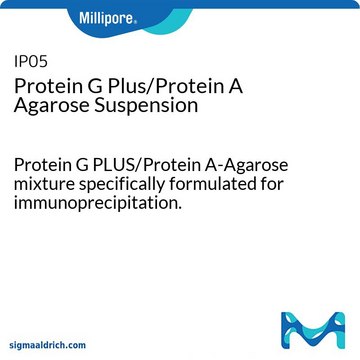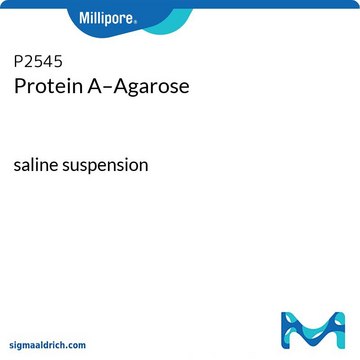IP04
Protein G Plus-Agarose Suspension
Protein G PLUS agarose suspension specifically formulated for immunoprecipitation.
Anmeldenzur Ansicht organisationsspezifischer und vertraglich vereinbarter Preise
Alle Fotos(1)
About This Item
UNSPSC-Code:
41116133
NACRES:
NA.56
Empfohlene Produkte
Form
slurry (Liquid)
Enthält
≤0.1% sodium azide as preservative
Hersteller/Markenname
Calbiochem®
Lagerbedingungen
do not freeze
Methode(n)
immunoprecipitation (IP): suitable
Eignung
suitable for immunoprecipitation
Versandbedingung
wet ice
Lagertemp.
2-8°C
Allgemeine Beschreibung
Designed for immunoprecipitation applications. This product is blocked with BSA to reduce non-specific binding and cannot be used for purification; best for bovine, goat, human, and rat IgG and for mouse IgG1.
Protein G PLUS agarose suspension specifically formulated for immunoprecipitation.
Warnhinweis
Toxicity: Standard Handling (A)
Sonstige Hinweise
Agarose solution is supplied ready to use. Protein G Plus agrarose is blocked with BSA and should not be used for immunoglobulin purification or covalent cross-linking. For immunoprecipitation reactions 15 µl/µg primary antibody is recommended. Preclearing will minimize extra bands resulting from nonspecific precipitation. To preclear, add to the sample 20 µl agarose conjugate and 1 µg normal IgG from the same species as the immunoprecipitating antibody. When immunoblotting is used for detection, some secondary antibodies can react nonspecifically with BSA or other proteins present at high concentrations in the sample. This can be eliminated by reducing the concentration of secondary antibody.
Rechtliche Hinweise
CALBIOCHEM is a registered trademark of Merck KGaA, Darmstadt, Germany
Lagerklassenschlüssel
11 - Combustible Solids
WGK
WGK 1
Flammpunkt (°F)
Not applicable
Flammpunkt (°C)
Not applicable
Analysenzertifikate (COA)
Suchen Sie nach Analysenzertifikate (COA), indem Sie die Lot-/Chargennummer des Produkts eingeben. Lot- und Chargennummern sind auf dem Produktetikett hinter den Wörtern ‘Lot’ oder ‘Batch’ (Lot oder Charge) zu finden.
Besitzen Sie dieses Produkt bereits?
In der Dokumentenbibliothek finden Sie die Dokumentation zu den Produkten, die Sie kürzlich erworben haben.
Kunden haben sich ebenfalls angesehen
Leo K Iwai et al.
Journal of proteome research, 9(6), 3135-3145 (2010-05-05)
Type 1 diabetes, in human patients and NOD mice, results from an immune attack on insulin-producing beta-cells of the pancreas by autoreactive T lymphocytes. In NOD mice, genetically controlled perturbations in the signaling pathways downstream of the antigen-specific T cell
Hayeong Kwon et al.
Journal of cellular and molecular medicine, 13(8A), 1549-1564 (2009-09-26)
Mitogenic regulation by caveolin-2 in response to insulin was investigated. Insulin triggered phosphorylation of caveolin-2 on tyrosine 19. Insulin increased the interaction between pY19-caveolin-2 and phospho-ERK, and that interaction was inhibited by a MEK inhibitor U0126. Insulin-induced interaction of caveolin-2
Kensuke Sakamoto et al.
Molecular biology of the cell, 21(16), 2966-2974 (2010-06-25)
CREB (cyclic AMP response element-binding protein) is a stimulus-induced transcription factor that plays pivotal roles in cell survival and proliferation. The transactivation function of CREB is primarily regulated through Ser-133 phosphorylation by cAMP-dependent protein kinase A (PKA) and related kinases.
Siqi Li et al.
The Journal of pathology, 254(3), 265-278 (2021-04-03)
Chemoresistance is a major obstacle to the treatment of triple-negative breast cancer (TNBC), which has a poor prognosis. Increasing evidence has demonstrated the essential role of cancer stem cells (CSCs) in the process of TNBC chemoresistance. However, the underlying mechanism
Roshia Ali et al.
Frontiers in oncology, 12, 841303-841303 (2022-03-12)
SNTA1 signaling axis plays an essential role in cytoskeletal organization and is also implicated in breast cancers. In this study, we aimed to investigate the involvement of actin cytoskeleton in the propagation of SNTA1/p66shc mediated pro-metastatic cascade in breast cancer
Unser Team von Wissenschaftlern verfügt über Erfahrung in allen Forschungsbereichen einschließlich Life Science, Materialwissenschaften, chemischer Synthese, Chromatographie, Analytik und vielen mehr..
Setzen Sie sich mit dem technischen Dienst in Verbindung.











